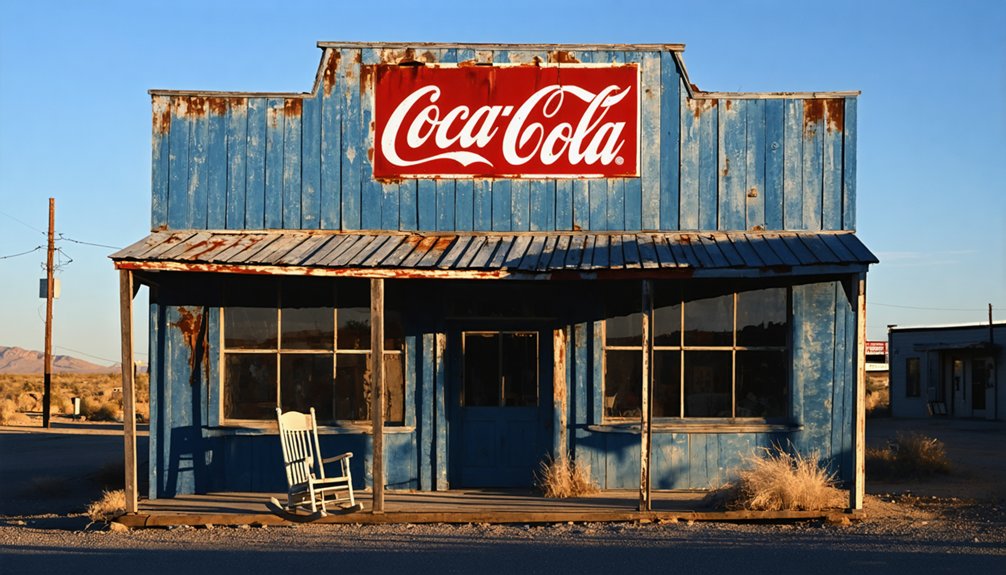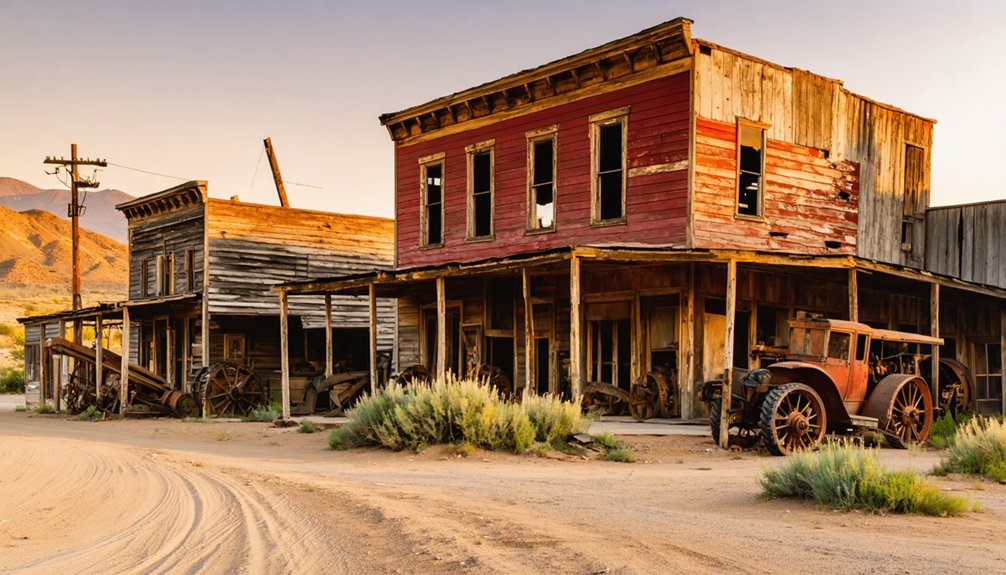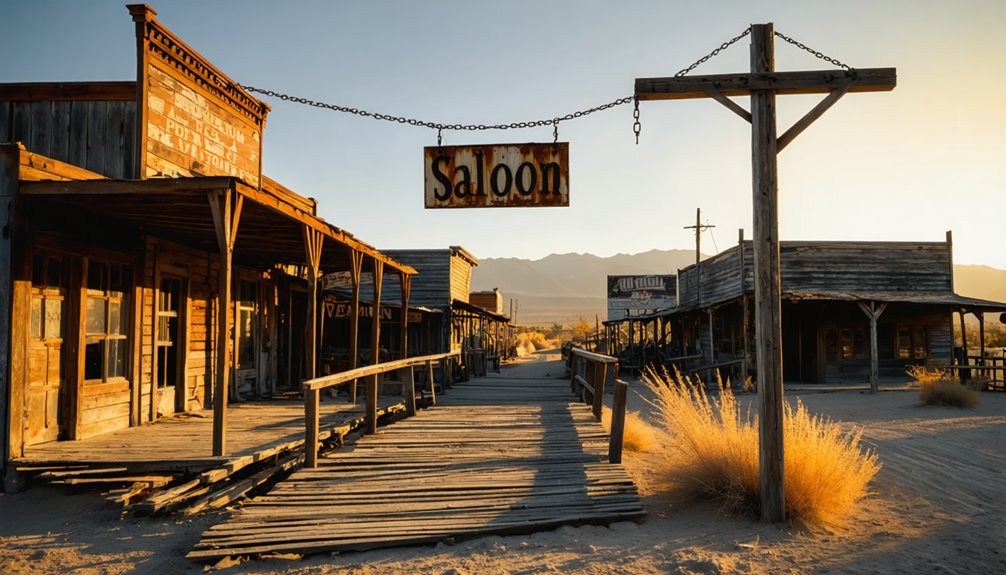Sullivan, California, boomed during the Gold Rush near Wood’s Creek and Tuolumne River junction. You’ll find remnants of a once-thriving town that supported 40 saloons, an opera house, and sophisticated mining operations. Miners worked twelve-hour shifts, earning $2.50-$4 daily while extracting gold using evolving techniques from panning to hydraulic methods. Today, weathered ruins and abandoned equipment dot the rugged landscape, whispering tales of ambition and hardship from California’s golden era.
Key Takeaways
- Sullivan was a gold mining boomtown established around 1848 during the California Gold Rush near the junction of Wood’s Creek and Tuolumne River.
- The town featured 31 steam hoisting works, 7 quartz mills, 40 saloons, and an opera house during its peak.
- Located in a rugged landscape with significant elevation changes, Sullivan is accessible via unpaved mountain roads requiring high-clearance vehicles.
- Visible remains include foundations of the general store, abandoned mining equipment, ore carts, shaft entrances, and processing facilities.
- Mining operations evolved from simple panning to advanced techniques like sluice boxes and stamp mills before the town was eventually abandoned.
The Rise and Fall of Sullivan’s Mining Era
As the California Gold Rush of 1848 swept across the Sierra Nevada foothills, Sullivan’s story began with the glint of gold in the sediments of Sullivan Creek.
You’d have witnessed the rapid transformation as miners flocked to the area, establishing Jacksonville at the junction of Wood’s Creek and Tuolumne River.
Sullivan’s economy thrived on gold extraction, evolving from simple panning to sophisticated mining techniques like sluice boxes and stamp mills. Many operations utilized traditional placer mining until they discovered it was ineffective for accessing the deeper hard-rock gold deposits.
By 1885, the Sullivan-Hemphill-Nobel Mine formalized operations, shifting from individual prospectors to corporate ventures.
Underground drifts and shafts reached deeper veins, requiring advanced technology and skilled workers. Unlike the Sullivan Mine in Kimberley, British Columbia, California’s Sullivan operation never achieved the same scale of production or longevity.
Geographical Location and Natural Surroundings
You’ll find Sullivan nestled in Kern County‘s portion of California’s Central Valley, positioned along historical trade routes that once connected it to Sacramento and other regional centers.
The abandoned settlement sits amid terrain that supported the area’s mining operations, with natural water sources that sustained its brief existence. Like many ghost towns that emerged during the mid-1800s, Sullivan experienced a period of rapid growth before its eventual decline.
Sullivan’s climate reflects the typical Central Valley pattern of hot, dry summers and mild winters, with native vegetation adapted to the interior continental conditions that challenged early settlers. Sullivan is actually located in Sutter County, contrary to some historical records that incorrectly place it elsewhere.
Terrain and Access Routes
Nestled within the rugged landscape of Kern County, Sullivan stands as a forgotten relic at approximately 35°37′17″N 118°28′27″W in California’s southern Sierra Nevada region.
The ghost town‘s rugged terrain features dramatic elevation changes with nearby peaks soaring beyond 8,000 feet. You’ll encounter sandy, rocky soil typical of desert-mountain conversion zones, with steep slopes and rocky outcrops dominating the landscape.
Access challenges abound when visiting Sullivan. You’ll need to navigate unpaved mountain roads requiring high-clearance vehicles. Like many of California’s ghost town remnants, Sullivan’s isolation contributes to its preservation despite natural deterioration.
CA-178 serves as the closest major highway, but expect rough conditions on the final approach. During winter months, snow and mud can render routes impassable, similar to how harsh winter conditions historically challenged Bodie’s inhabitants.
Look for trailheads and old mining roads that serve as entry points to this remote historical site.
Climate and Vegetation
Sullivan’s climate reveals itself through five distinct seasonal patterns that define this forgotten corner of the Sierra Nevada foothills.
You’ll experience scorching summers exceeding 90°F, contrasted by mild winters with occasional frost but little snow. This climate variability shapes the sparse landscape you’ll encounter.
As you wander the ghost town’s perimeter, notice the vegetation adaptations surrounding you—drought-resistant California oaks standing sentinel among sagebrush and chaparral. Similar to the endorheic lake of the Salton Sea, this area has limited water drainage.
Their waxy leaves and deep roots tell stories of survival in this semi-arid terrain. After winter rains, brief wildflower blooms transform the landscape, then quickly retreat as summer’s heat returns.
The resilient plants form critical habitat for foothill wildlife, creating a delicate ecological balance in this changing zone between desert and mountain ecosystems. The dramatic backdrop of peaks over 14,000 feet creates a stark contrast to the arid valley floor.
Daily Life in a California Boom Town

Life in a California boom town like Sullivan revolved around the unrelenting rhythm of a twelve-hour workday, six days a week. You’d earn between $2.50 and $4 daily depending on your skills, returning each night to a bunkhouse if single or a redwood clapboard cabin if married with children.
Your daily routines might include working at one of the 31 steam hoisting works or 7 quartz mills that defined the industrial landscape. Similar to Los Angeles in the 1880s, these boom towns saw a rapid population increase from 11,000 to 50,000 within a decade. Those who didn’t strike it rich often remained in California as merchants or farmers, establishing permanent communities.
The constant hiss and pound of Sullivan’s 31 steam hoists and 7 quartz mills sculpted both the landscape and the worker’s existence.
After work, you’d find social interactions in one of the 40 saloons that never closed, or perhaps at the opera house where an afternoon’s entertainment cost just 38 cents.
Women, though a minority, kept society functioning as cooks, laundresses, seamstresses, and store clerks.
The town’s 400+ businesses served the diverse needs of 10,000-15,000 residents from across the globe.
Notable Buildings and Structural Remains
As you wander through Sullivan’s haunting landscape, the weathered mining operations stand as silent sentinels to the town’s prosperous past.
The general store foundations, now merely stone outlines against the parched earth, once served as the community’s vibrant commercial center where miners exchanged gold for supplies.
Among the collapsed housing remnants, you’ll find scattered personal artifacts that tell intimate stories of the families who abandoned their homes when the gold eventually ran out.
Weathered Mining Operations
The weathered shells of once-bustling mining operations stand as silent sentinels throughout Sullivan’s rugged landscape. As you explore this forgotten California outpost, you’ll notice how time has transformed industrial ambition into haunting artifacts of the past.
While specific historical records of Sullivan remain elusive, the site follows patterns seen in other California ghost towns where abandoned mining equipment and weathered structures tell stories of boom-and-bust cycles.
Rusty ore carts, collapsed shaft entrances, and the skeletal remains of processing facilities hint at the scale of operations that once defined this community.
These mining relics, now reclaimed by the desert elements, offer a raw, unfiltered glimpse into California’s gold rush era when fortune-seekers gambled everything on the promise of mineral wealth.
General Store Foundations
Among the most evocative ruins in Sullivan’s weathered landscape stand the crumbling foundations of what once served as the town’s commercial heart.
While specific records of Sullivan’s general store remain elusive in historical archives, its foundations likely resemble those of similar California ghost towns like Bodie and Cerro Gordo.
You’d typically find rectangular stone outlines marking where wooden structures once stood, with scattered remnants of early settler commerce partially reclaimed by the desert.
Sullivan history enthusiasts speculate the store architecture followed practical frontier design—simple and functional with a false front façade common to Western commercial buildings.
Without archaeological documentation, these foundations speak their own silent language, inviting you to imagine the bustling trade that once animated this now-quiet corner of California’s gold country.
Collapsed Housing Remnants
Beyond the general store’s stone outline, Sullivan’s residential quarters tell a more intimate story of frontier life.
You’ll encounter timber frames and partial walls scattered throughout the original street grid, revealing a dense community layout of small one to two-room dwellings.
As you navigate between unstable debris piles, notice the collapsed structures with their fallen chimneys and exposed fireplaces.
Charred wood suggests some homes succumbed to fire, while others simply surrendered to time. The remnants display early 20th-century materials—corrugated metal, wired glass, and rusted fittings—now blending with encroaching vegetation.
The collapsed housing clusters around what were once communal buildings, hinting at how closely these frontier families lived.
Foundation patterns occasionally reveal small porches or attached storage sheds, silent witnesses to everyday lives long abandoned.
Mining Operations and Technical Innovations
Gold mining operations in Sullivan followed a familiar pattern seen throughout California’s mining regions, evolving from simple placer mining to more sophisticated extraction methods as surface gold became scarce.
You’d have witnessed remarkable mining techniques as operations progressed – from creek bed panning to hydraulic giants blasting hillsides with pressurized water.
Technological advancements transformed Sullivan’s landscape as miners developed quartz extraction methods requiring extensive support structures for wide veins exceeding sixty feet.
The People of Sullivan: Stories and Legacies

Though time has eroded many of their stories, the people who once called Sullivan home created a vibrant community that thrived and faded with the town’s fortunes. Miners and their families formed the backbone of Sullivan’s population, with thousands residing there during the boom years.
You’ll find community narratives centered around the town’s communal hubs—saloons, general stores, and churches—where residents shared their daily triumphs and hardships.
Mining folklore, including tales of accidents and ghostly encounters, persists even as the physical town crumbled.
The whispers of Sullivan’s past echo through abandoned shafts, where spectral miners still seek fortune in the darkness.
The rapid abandonment left little biographical data of notable individuals, though their legacy lives on through artifacts, structures, and oral histories passed down by descendants who preserve the memory of Sullivan as a symbol of frontier perseverance.
Accessing Sullivan Today: Visitor Information
Where can curious explorers find Sullivan’s weathered remains in today’s landscape?
Unfortunately, detailed visitor information about Sullivan, California Ghost Town remains elusive in current records. Unlike well-documented ghost towns such as Bodie State Historic Park or Calico, Sullivan’s visitor accessibility details aren’t readily available through conventional sources.
To discover Sullivan’s forgotten pathways, you’ll need to contact local historical societies, California State Parks, or regional tourism boards directly.
These organizations might maintain archives detailing the site’s exact location, preservation status, and any local regulations governing access. Some ghost towns require permits or have restricted entry due to safety concerns or private ownership.
Before starting your journey to this lesser-known historical fragment, conduct thorough research to guarantee respectful and legal exploration of California’s vanishing past.
Photographic Journey Through Time

Through faded sepia tones and cracked emulsion, Sullivan’s forgotten story comes alive in the photographs that remain its most tangible legacy.
These black-and-white images capture deserted streets and weathered buildings, chronicling the ghost town’s evolution from thriving mining hub to abandoned relic.
In photographic archives throughout California, you’ll find glass plate negatives and hand-tinted prints documenting Sullivan’s mining operations—headframes and ore carts frozen in time.
Sequential photos reveal nature’s gradual reclamation of human endeavors, showing how floods and avalanches toppled structures already weakened by neglect.
The most compelling images feature the people themselves: miners’ faces etched with determination, families posed before simple wooden cabins, a community that briefly flourished before vanishing into the landscape, leaving only their photographic ghosts behind.
Preservation Efforts and Historical Significance
Unlike many abandoned settlements that have succumbed entirely to nature’s reclamation, Sullivan—more commonly known as Bodie—stands as a remarkable representation of deliberate preservation.
Since becoming a State Historic Park in 1962, it’s maintained through “arrested decay” preservation techniques, allowing you to experience authentic 19th-century mining life without modern restoration altering its character.
Arrested decay freezes Bodie in time, preserving authenticity where modern restoration would erase frontier character.
When you visit, you’ll witness the collaborative efforts of state agencies, historical societies, and dedicated volunteers working to protect this Gold Rush monument against harsh weather, vandalism, and natural deterioration.
The town’s original structures and historical artifacts provide tangible connections to frontier existence, illustrating boom-and-bust economics that defined Western expansion.
Despite challenges like limited funding and environmental threats, Bodie continues educating visitors about mining technologies and settlement patterns that shaped California’s development.
Frequently Asked Questions
Are There Documented Paranormal Activities or Ghost Sightings in Sullivan?
No, there are no documented ghostly encounters or spectral sightings in Sullivan. You won’t find verified paranormal activities there, unlike other California ghost towns that boast established supernatural histories.
What Natural Disasters or Accidents Contributed to Sullivan’s Abandonment?
You’d likely find that earthquake impacts were minimal in Sullivan’s decline. Instead, economic factors played the decisive role, though flood events may have damaged infrastructure, hastening the town’s final abandonment alongside depleted mining resources.
Did Any Famous Historical Figures Visit or Live in Sullivan?
You won’t find evidence of famous visitors in Sullivan’s dusty remains. Historical impact records show no notable figures ever called this forgotten California settlement home or passed through its gates.
Were Indigenous Communities Displaced During Sullivan’s Development?
Ancestral lands became colonial plunder—yes, Wintu communities faced severe displacement impacts when Sullivan emerged. You’ll find their indigenous heritage erased as miners seized riverside territories during the gold-fueled settlement expansion.
What Plants or Wildlife Have Reclaimed the Sullivan Ghost Town Site?
You’ll find chaparral species like sagebrush and California buckwheat dominating the native vegetation, while ground squirrels, cottontails, and red-tailed hawks have transformed abandoned structures into thriving wildlife habitats at Sullivan.
References
- https://www.camp-california.com/california-ghost-towns/
- https://www.nps.gov/deva/learn/historyculture/death-valley-ghost-towns.htm
- https://www.mentalfloss.com/geography/american-ghost-towns-can-still-walk-through
- https://en.wikipedia.org/wiki/List_of_ghost_towns_in_California
- https://www.youtube.com/watch?v=ElbXVNDurPc
- https://thehauntghosttours.com/tours/solvang/
- https://en.wikipedia.org/wiki/Solvang
- https://nvtami.com/2021/06/15/sullys-tourist-camp-nevada/
- https://discover.hubpages.com/travel/Ghost-Towns-in-California
- https://en.wikipedia.org/wiki/Sullivan_Mine



